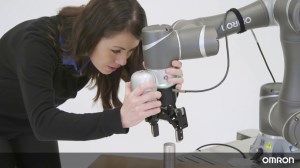The human and robot interface could not be more different than what is typically depicted by Hollywood.
Terminator, The Matrix and I, Robot are just some of the movies that portrayed robots as opposing forces to humans.
In actual fact, humans have a history of working with robotics since as early as 1937 when a robot powered by a single motor was engineered for industrial applications. The robot, which followed patterns on punched paper tapes, could be pre-programmed to perform various simple tasks.
Today, we fully recognise the value of robotics in the manufacturing industry as robots have consistently supported us in our work, often taking on dangerous, menial or routine tasks.
They have freed up many human colleagues so to do more creative and value-added work.
The human-robot interface has taken a sharp turn for the better in recent times through the introduction of robots that have been designed, from their inception, with collaboration in mind – cobots. The value provided of cobots go beyond alleviating humans from routine tasks.
Cobots are engineered to operate safely alongside or in close proximity with human works such as in a factory line or a modular manufacturing environment.
The potential for interaction and interoperability between both parties is key to harnessing a harmonious factory line with cobots and humans complementing each other’s strength and weaknesses.
Cobots – the next-generation coworker
The notion that robots and humans can be ‘coworkers’ was quite unthinkable not too long ago.
Previously, serious distance used to be kept between human workers from robots in action, as this protected the human workers from the hard steel, heavy bulk and rapid movements typical in earlier generations of industrial robots.
Early robots were typically caged and confined within dedicated work cells, out of bound except to humans except for maintenance workers.
However, technology has evolved to a point where both humans and robots can coexist on the factory floor working side by side. Today’s cobots are equipped with sensors that can detect nearby obstacles – humans and objects – with pinpoint accuracy, allowing them to stop movements immediately or make adjustments to avoid causing harm to human workers.
The Omron LD, for example, is no bull in the china shop. Equipped with dynamic route adjustment functions, the cobot navigates expertly around workers, tight corridors and busy factory lines, hence avoiding any chances of collision and mayhem.
Cobots are also easier to train and deploy compared to early generation robots. While the more traditional industrial robots could take weeks to be operational, cobots can be configured in just a few hours. This versatility makes them ideal for all stages of production.
Some models can also be configured remotely and learn through demonstration, paving the way for a truly “plug and produce” manufacturing solution.
More than just a supporting role
Cobots are proving to be valuable assets to manufacturers with their ease of deployment, intelligence and versatility. More importantly, cobots’ ability to safely operate and navigate around human workers on the factory floor makes them ideal ‘partners’ in manufacturing.
In addition to these attributes, artificial intelligence technology can also be tapped on to fully harness the potential of cobots, allowing them to be turned into smart machines that can take on more sophisticated roles and perform more than menial and repetitive tasks.
AI-driven cobots, for instance, can recognize the presence and orientation of different manufacturing parts and perform inspections to ensure quality control. With such intelligent capabilities, they can also complement their human colleagues with their ability to detect manufacturing failure signs and take steps against risks normally unnoticeable to human beings.
These are just a couple of instances of how cobots can be expected to participate in more crucial activities and take on more proactive roles due to their ability to sense and control production activities.
Cobots also sharpen human-robot interoperability, which is at the crux of the “4M sensing technology” framework envisioned by Omron’s researchers to provide an idea of the dynamics that will be commonplace in factories of the future.
This framework encapsulates four critical factors of the modern factory – man, machine, material and method. It provides a foundation for humans and machines to work in the same environment.
These four factors are inter-connected through artificial intelligence and provide an exchange of information and knowledge between man and machine.
The skilled human worker imparts valuable knowledge to machines who can reproduce their skills at mechanical scale. In return, robots and machines detect failure symptoms that can be unnoticeable even by skilled engineers.
Respite to a challenging environment
Manufacturing businesses today are facing tremendous pressure from competition, increasingly complex customer demands and industry disruption brought about by newer technologies.
Many manufacturers are reaching a tipping point where standard automation can no longer help them meet the rapidly evolving challenges they are facing.
Cobots are therefore making a timely entrance into factories, providing immense value to manufacturers and workers operating on the factory floor.
Close integration between humans and cobots will be instrumental to a successful factory of today. With both parties complementing each other’s strengths and weaknesses, the efficiency and output of factories can benefit tremendously.
Swaminathan Vangal-Ramamurthy is General Manager of Robotics Business Division, Omron Asia Pacific


